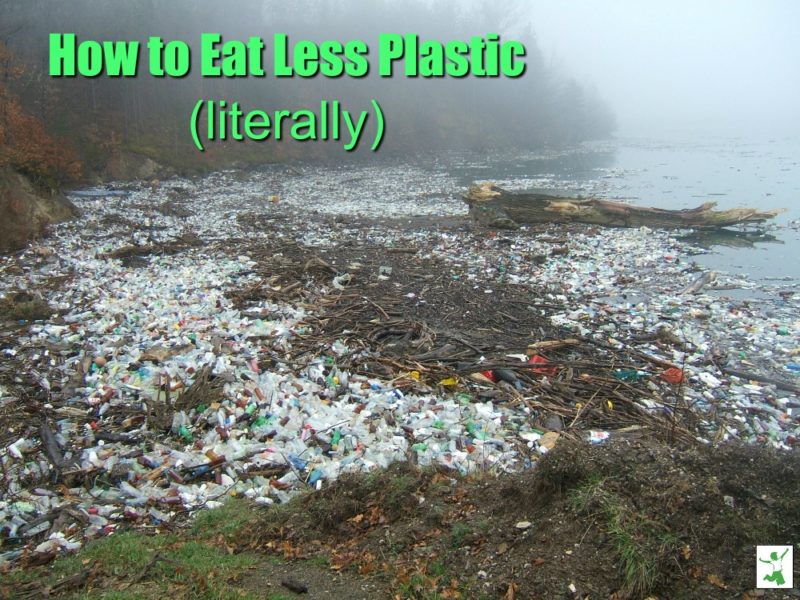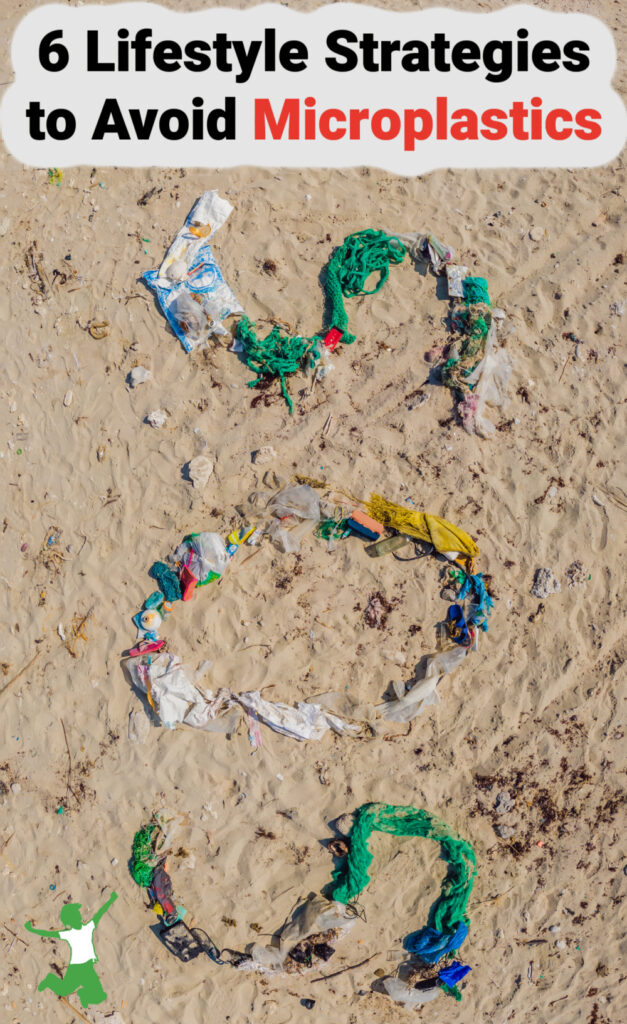Table of Contents[Hide][Show]
Important lifestyle strategies for eliminating ingestion of microplastics that are contaminating food and water supplies around the world.

When we think of eating plastic, what usually comes to mind are sea turtles mistaking plastic bags for jellyfish or large sharks with stomachs full of ocean trash.
The harsh truth is that the level of plastic pollution in the world is now so pervasive that tiny pieces of microplastic are turning up everywhere in nature with humans all across the globe…including you and me…eating plenty of it too!
A Credit Card per Week of Microplastics
According to research conducted at the University of Newcastle in Australia, the average human is now potentially eating approximately 5 grams (a credit card’s worth) of microplastics every week. This equates to about 2000 tiny pieces that are 5 mm or smaller in size… imperceptible in most cases. (1)
Another study published in June 2019 estimates that the average American ingests at least 74,000 microplastic particles every year just by eating, drinking, and breathing. (2)
Yes, breathing.
There is so much plastic everywhere that we inhale tens of thousands of tiny plastic fragments or fibers every year. (3)
So, the question really isn’t how to avoid eating microplastics. It is already in our food and water supply!
We are ALL eating it folks.
“It’s in all of us and we can’t escape consuming plastics”, says Marco Lambertini, Director General of the Worldwide Fund for Nature.
The real question, then, is how to eat as little as possible, because as Pete Myers, Ph.D., founder and chief scientist of the nonprofit Environmental Health Sciences and an adjunct professor of chemistry at Carnegie Mellon University, bluntly says,
There cannot be no effect. (4)
How to Avoid Eating, Drinking and Breathing Microplastics
Research into the effect of microplastics on human health is very new.
However, the small number of studies to date are ominous.
There is evidence in animals that microplastics have the ability to get into the brain, bypassing the hardy membrane that is supposed to protect it from foreign matter that gets into the bloodstream. (5)
Mothers may pass microplastics onto a developing fetus via the placenta according to as yet unpublished research presented at the Rutgers Center for Urban Environmental Sustainability. (6)
Then there are the hormone-disrupting problems that emerge from the chemicals…bisphenol A (BPA) and phthalates…in the microplastic particles themselves.
The bottom line is not to wait for evidence to emerge as front-page news that microplastic consumption is a huge problem.
It is best to be pro-active and start developing strategies now for avoiding them.
Here are my top 6 suggestions to consider.
Switch to Clean Sea Salt
Testing of various foods reveals that sea salt is one of the most microplastic-contaminated foods on the planet.
This is terribly sad as consumption of pure sea salt with all its beneficial trace minerals is a boon to health!
However, sea salts derived from the oceans are now regularly found to contain hefty doses of microplastics.
Greenpeace estimates that the average person consumes over 2000 microplastic particles per year from salt alone.
Celtic sea salt used to be my favorite, but I don’t buy it anymore. This type of sea salt produced by evaporation of seawater has the highest level of plastic contamination. (7)
Given that plastics, particularly tiny pre-production pellets known as nurdles now pollute even the most remote beaches, this is not so surprising. (8, 9)
My solution to this problem was to opt for this brand of sea salt from the Sea of Cortez. It is tested to be free of contaminants and microplastics. It also contains the highest amount of trace minerals of any sea salt in the world.
Avoid Drinking Water Out of Plastic Bottles
Research shows that water bottled in plastic has roughly double the number of microplastics as tap water. (10)
Think your bottled water is special? Probably not. Testing indicates that 93% of the bottled waters from around the world are contaminated. (11)
Filter that tap water with a quality water filtration system, and the amount of plastic ingested goes to virtually zero.
That’s a slam dunk, folks!
And no, a cheap pitcher filter that simply improves the taste of tap water is not going to do the job.
If you are relying on water from plastic bottles for hydration, it is time to make the switch to reusable stainless steel or glass water bottles filled from a filtered kitchen tap and ditch the plastic for good.
Skip Beverages Made with Unfiltered Water
Beer is potentially one of the most microplastic-contaminated beverages. Researchers from the University of Minnesota detected microscopic fibers and particles in every sample of 12 brands of beer made with water from the Great Lakes. (12)
While definitely a logical leap, it is not so far-fetched to assume that any bottled or canned beverage made with water that isn’t properly filtered is going to be contaminated.
The best alternative? Make your own homemade beverages with filtered water from your tap.
Second best? Consume beverages from brands that use filtered water.
Stop Using Premium Teas
Premium tea packaged in mesh tea bags is one of the biggest sources of microplastic ingestion. Frequently, these brands are organic, which makes the choice of packaging in plastic even more shocking.
Researchers found that a single mesh tea bag releases about 11.6bn microplastic and 3.1bn smaller nanoplastic particles into the hot water.
Paper tea bags or buying tea in bulk is a much better way to enjoy your tea!
Eat More Freshly Prepared Food
I haven’t found any data on microplastics in produce. However, it would seem safe to assume that the levels would be far lower than processed foods.
Avoid all items that come in cans, tetra packs, and cartons as these packages are lined with plastic that almost certainly leaches into the food.
Avoid takeout and drive-through fast food as much as possible too, as the paper used to wrap the food or line the styrofoam/pizza box containers are commonly treated with plasticizing PFAS chemicals that are linked to cancer.
Practice Safe Handling of Plastic
It amazes me that some people actually still heat plastic-wrapped food in a microwave! Warnings against the practice have been going around for many years.
Use common sense. Don’t heat or otherwise microwave food that is in contact with plastic – ever.
The American Academy of Pediatrics also recommends not putting plastic in your dishwasher. Wash in lukewarm water with mild dish soap only. (13)
The most dangerous kinds of plastic are those with recycling codes “3,” “6,” and “7”. These numbers indicate the presence of phthalates, styrene, and bisphenols.
The safest type of plastic, if there is such a thing, are those labeled as “biobased” or “greenware,” that do not contain bisphenols. But, they absolutely do contain other petrochemicals, so don’t be lured into a false sense of security with them.
What strategies are you following in your home?









I have also heard of Redmond salt potentially being effected by atomic testing in the area. However, I cannot remember where I heard that. Does anyone have more information on this? I hope it is not true.
What do you know about PEX for plumbing?
Bummer… I thought I was doing well with my Mediterranean Sea salt. 🙂 So glad to know that it’s an easy fix though. Thanks for the Redmond’s recommendation – I feel like I’ve seen that salt at my local Wegmans, so I’ll have to check next time I’m there. Also, if you have time to answer an unrelated question, what beverages do you order when you’re at a restaurant? Ordering water would appear to be the healthy choice, but not nasty fluorinated city water. Just curious as to what you do. Thanks!!!
Good question! I try to get water in a glass bottle like perrier or Pelligrino.
Excellent! Thanks for the reply!
I have used and still use Celtic salt, but not any more, and a salt from France , Fleur de Sel,that supposedly did not show plastic in it.My integrative doctor many years ago was skeptical of Redmond salt because of all the atomic bomb testing that was done in the area where the salt was mined. I don’t know how radiation would effect the mining of this salt? It is so upsetting that everything is so polluted. No wonder people are having thyroid issues with all the hormone disrupters we are ingesting.
Could you recommend a particular brand of bowls and cups for children?
What about Corelle dishes from Corning Glass Works? They are virtually unbreakable and what my Mom used while I was growing up. I use it too… still seems one of the best, most affordable choices out there. You can get very small plates and bowls that are child size too.
I just bought a travel silverware and straw set. I’m looking into getting our church enough stainless steel silverware to replace the hundreds of plastic utensils we use each year. I switched our water bottles to glass or stainless steel.
Good for you! I think many people feel paralyzed because the problem is so vast, but if we simply do what we can do individually, that would be enough!
On a slightly different topic, I think it is so important to eliminate using single use plastics as much as possible. I was organic before it was cool and…I really believe that little changes we each make can create huge waves of change in how much plastic consumption is going on. I am now using laundry soap that comes in a cardboard box, all of my storage containers are glass or stainless steel and I have lots of re-usable bags and almost never need to use plastic ones. I also take my own glass jars to the bulk bins at the market, like I used to do in the old days! Every moment in life that I have de-plastic-ed brings greater peace to my spirit! Its a bit ridiculous how much I am enjoying avoiding plastic whenever possible.
I think legislation banning all single use plastic is the only way out of this mess. I am not of the political persuasion that legislating behavior which should be market driven is the best course of action either. It seems to me, though, that waiting for enough companies and people to change their habits make a difference is going to take too long. The ocean is already so contaminated.
Great info you gave on sea salt. Who knew?
I even question how pure organic produce is after seeing an article on “Mercola” (2 or 3 months ago?) about organic producers using huge sheets of plastic to cover the soil around the crops to discourage weed growth. I’d like to know if any studies have been done regarding chemicals leaching into the soil and being absorbed by the crops.
Wow I didn’t know that about the recycling codes! I just checked and my breast pump flanges are a code 6! 🙁
That is a huge bummer because I just bought a huge bag of celtic sea salt after reading your recent article about it and now you say it is bad for me. I hope you pull that article to save other people some money.
I bought Celtic sea salt for decades, so yes, in some of my older articles I talk about it …. very sad isn’t it 🙁
I would just use it up … I used up my Celtic salt (I had a large bag!) before switching. I certainly didn’t waste it.